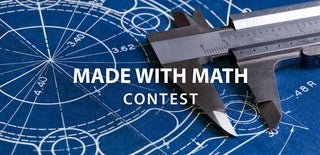Introduction: Are You Looking for the Golden Proportion in the City?
This project is about creating a golden ratio rectangle with the mathematical software Geogebra and then use this object to design a 3D model with this golden proportion to be able to make it with a 3D printer. This model can be used to identify this proportion in monuments of your city and enjoy a nice mathematical journey.
Supplies
To carry out this project you will need:
- Geogebra software
- 3D printer. I have used Creality Ender 3 pro.
- Your favourite colour PLA
Step 1: Create a Golden Rectangle With Geogebra
Follow the next steps to create a golden rectangle with Geogebra:
- Create an square, mark the midpoint of the lower side and draw a segment from this midpoint to the upper right-hand vertex.
- Draw a circumference whose radius is this segment.
- Draw a line through the lower side of the square and find the intersection between the line and the circumference.
- The distance between the first vertex of the square and this cut-off point is the golden number. Draw this segment and hide the elements that are not necessary.
- Draw a parallel line to the vertical side of the square through the intersection point described above.
- Draw a parallel line to the golden segment through the top side of the square.
- Calculate the intersections corresponding to the corners of the golden rectangle with these lines and define the golden rectangle.
Step 2: Save As 3D Print File
Once the rectangle is done, you mus save it to a stl file.
It is better to keep the rectangle 100% filled and and keep the 4 points.
Click on "Download as..." and "3D print (.stl)".
If you want, you can leave the saving options as they are.
Step 3: It's Time to Create the 3D Mode
To create the 3D model with the golden rectangle, you can work with Tinkercad.
Create an additional solid structure and put inside the golden rectangle exported from Geogebra. It is better to make the height of the rectangle larger than the other object to clearly view the overlapping of the objects.
You can also include letters to indicate the proportion (I make it in Spanish).
Define both like a hole shape and combine the three objects.
Step 4: Export and Print the Model
Download the stl file and prepare it for 3D printing. I have used the following parameters using Cura Ultimaker:
- Cubic infill 20%
- 210 ºC printing temperature.
- 60 ºC Build plate temperature
- 0.2 mm layer hight
Attachments
Step 5: It's Time to Look for the Golden Ratio
Now it's your time to go for a walk around your city. Look for a beautiful historical building and check if any rectangular element of its front has the golden ratio.
In the pictures included in this section you can see a historic building from Cordoba, Spain. It is a door of the archaeological museum of this city. A building with a Renaissance style facade and a main door that has the golden ratio.
This 3D model is also an ideal accessory for your travels.

Runner Up in the
Made with Math Contest















